您好,登錄后才能下訂單哦!
您好,登錄后才能下訂單哦!
這篇文章給大家介紹怎么在ASP.NET Core項目中實現一個微信登錄功能,內容非常詳細,感興趣的小伙伴們可以參考借鑒,希望對大家能有所幫助。
工具:
Visual Studio 2015 update 3
Asp.Net Core 1.0
1 準備工作
申請微信公眾平臺接口測試帳號,申請網址:(http://mp.weixin.qq.com/debug/cgi-bin/sandbox?t=sandbox/login)。申請接口測試號無需公眾帳號,可以直接體驗和測試公眾平臺所有高級接口。
1.1 配置接口信息
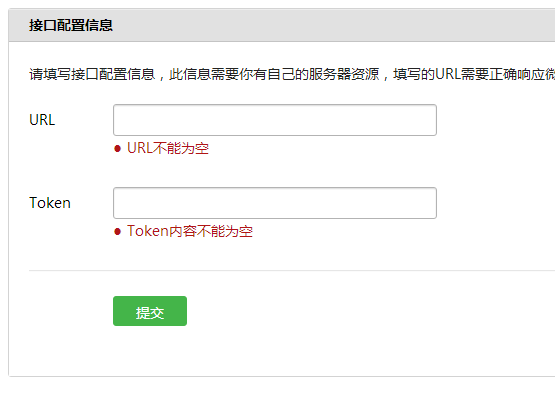
1.2 修改網頁授權信息
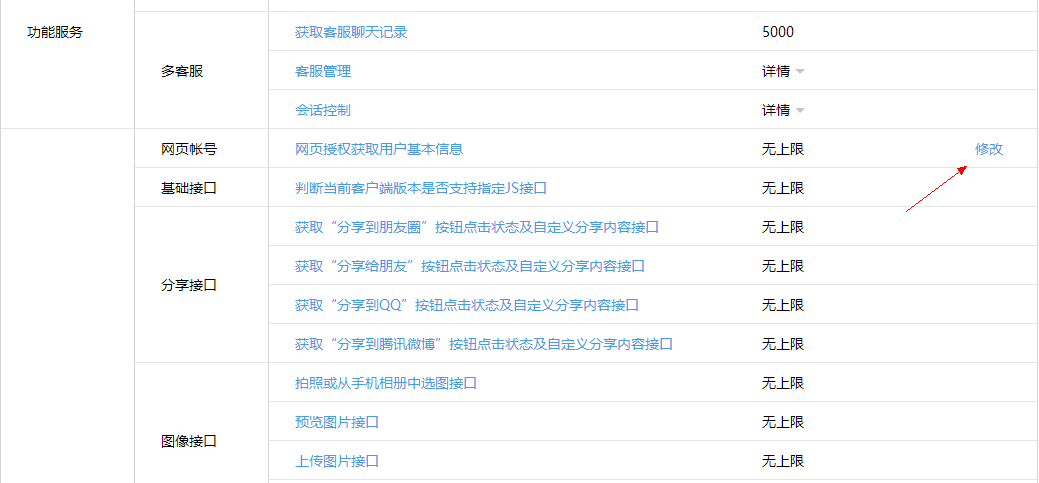
點擊“修改”后在彈出頁面填入你的網站域名:
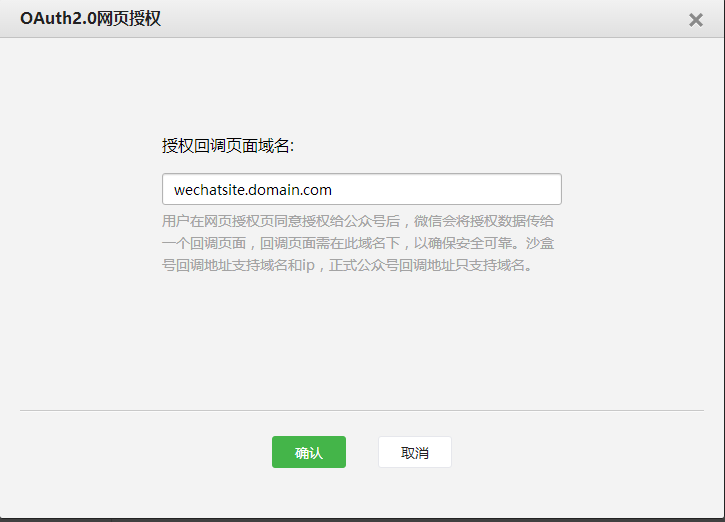
2 新建網站項目
2.1 選擇ASP.NET Core Web Application 模板
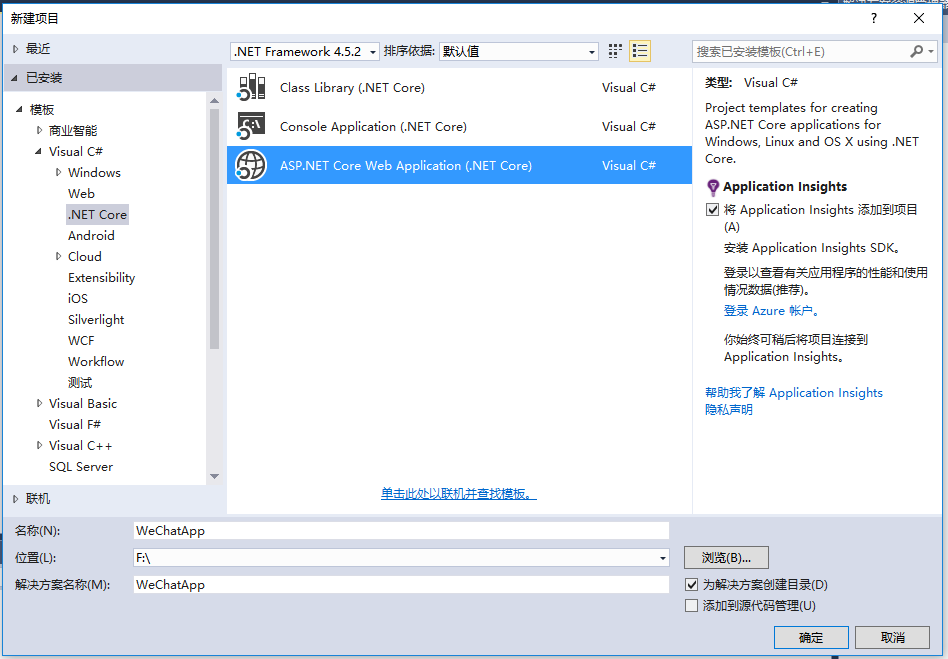
2.2 選擇Web 應用程序,并更改身份驗證為個人用戶賬戶

3 集成微信登錄功能
3.1添加引用
打開project.json文件,添加引用Microsoft.AspNetCore.Authentication.OAuth
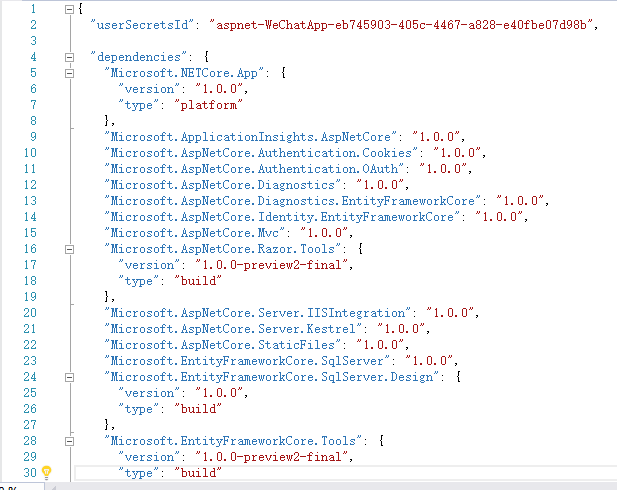
3.2 添加代碼文件
在項目中新建文件夾,命名為WeChatOAuth,并添加代碼文件(本文最后附全部代碼)。
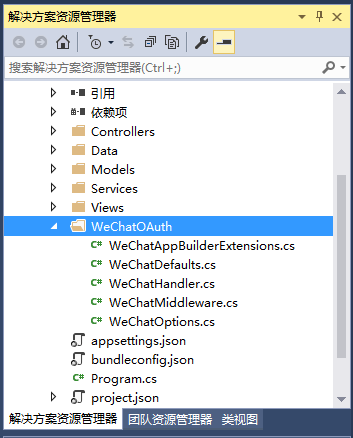
3.3 注冊微信登錄中間件
打開Startup.cs文件,在Configure中添加代碼:
app.UseWeChatAuthentication(new WeChatOptions()
{
AppId = "******",
AppSecret = "******"
});注意該代碼的插入位置必須在app.UseIdentity()下方。
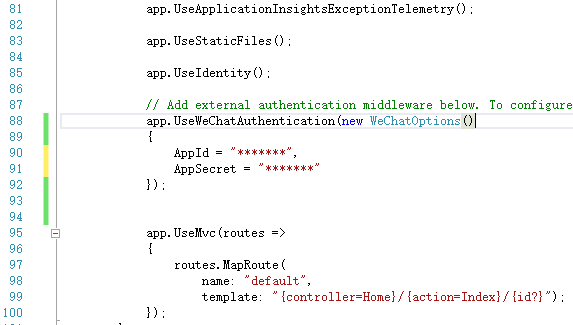
4 代碼
WeChatAppBuilderExtensions.cs:
// Copyright (c) .NET Foundation. All rights reserved.
// Licensed under the Apache License, Version 2.0. See License.txt in the project root for license information.
using System;
using Microsoft.AspNetCore.Authentication.WeChat;
using Microsoft.Extensions.Options;
namespace Microsoft.AspNetCore.Builder
{
/// <summary>
/// Extension methods to add WeChat authentication capabilities to an HTTP application pipeline.
/// </summary>
public static class WeChatAppBuilderExtensions
{
/// <summary>
/// Adds the <see cref="WeChatMiddleware"/> middleware to the specified <see cref="IApplicationBuilder"/>, which enables WeChat authentication capabilities.
/// </summary>
/// <param name="app">The <see cref="IApplicationBuilder"/> to add the middleware to.</param>
/// <returns>A reference to this instance after the operation has completed.</returns>
public static IApplicationBuilder UseWeChatAuthentication(this IApplicationBuilder app)
{
if (app == null)
{
throw new ArgumentNullException(nameof(app));
}
return app.UseMiddleware<WeChatMiddleware>();
}
/// <summary>
/// Adds the <see cref="WeChatMiddleware"/> middleware to the specified <see cref="IApplicationBuilder"/>, which enables WeChat authentication capabilities.
/// </summary>
/// <param name="app">The <see cref="IApplicationBuilder"/> to add the middleware to.</param>
/// <param name="options">A <see cref="WeChatOptions"/> that specifies options for the middleware.</param>
/// <returns>A reference to this instance after the operation has completed.</returns>
public static IApplicationBuilder UseWeChatAuthentication(this IApplicationBuilder app, WeChatOptions options)
{
if (app == null)
{
throw new ArgumentNullException(nameof(app));
}
if (options == null)
{
throw new ArgumentNullException(nameof(options));
}
return app.UseMiddleware<WeChatMiddleware>(Options.Create(options));
}
}
}WeChatDefaults.cs:
// Copyright (c) .NET Foundation. All rights reserved.
// Licensed under the Apache License, Version 2.0. See License.txt in the project root for license information.
namespace Microsoft.AspNetCore.Authentication.WeChat
{
public static class WeChatDefaults
{
public const string AuthenticationScheme = "WeChat";
public static readonly string AuthorizationEndpoint = "https://open.weixin.qq.com/connect/oauth3/authorize";
public static readonly string TokenEndpoint = "https://api.weixin.qq.com/sns/oauth3/access_token";
public static readonly string UserInformationEndpoint = "https://api.weixin.qq.com/sns/userinfo";
}
}WeChatHandler.cs
// Copyright (c) .NET Foundation. All rights reserved.
// Licensed under the Apache License, Version 2.0. See License.txt in the project root for license information.
using Microsoft.AspNetCore.Authentication.OAuth;
using Microsoft.AspNetCore.Builder;
using Microsoft.AspNetCore.Http.Authentication;
using Microsoft.AspNetCore.Http.Extensions;
using Microsoft.Extensions.Primitives;
using Newtonsoft.Json.Linq;
using System;
using System.Collections.Generic;
using System.Net.Http;
using System.Net.Http.Headers;
using System.Security.Claims;
using System.Text;
using Microsoft.AspNetCore.Mvc;
using System.Threading.Tasks;
namespace Microsoft.AspNetCore.Authentication.WeChat
{
internal class WeChatHandler : OAuthHandler<WeChatOptions>
{
public WeChatHandler(HttpClient httpClient)
: base(httpClient)
{
}
protected override async Task<AuthenticateResult> HandleRemoteAuthenticateAsync()
{
AuthenticationProperties properties = null;
var query = Request.Query;
var error = query["error"];
if (!StringValues.IsNullOrEmpty(error))
{
var failureMessage = new StringBuilder();
failureMessage.Append(error);
var errorDescription = query["error_description"];
if (!StringValues.IsNullOrEmpty(errorDescription))
{
failureMessage.Append(";Description=").Append(errorDescription);
}
var errorUri = query["error_uri"];
if (!StringValues.IsNullOrEmpty(errorUri))
{
failureMessage.Append(";Uri=").Append(errorUri);
}
return AuthenticateResult.Fail(failureMessage.ToString());
}
var code = query["code"];
var state = query["state"];
var oauthState = query["oauthstate"];
properties = Options.StateDataFormat.Unprotect(oauthState);
if (state != Options.StateAddition || properties == null)
{
return AuthenticateResult.Fail("The oauth state was missing or invalid.");
}
// OAuth3 10.12 CSRF
if (!ValidateCorrelationId(properties))
{
return AuthenticateResult.Fail("Correlation failed.");
}
if (StringValues.IsNullOrEmpty(code))
{
return AuthenticateResult.Fail("Code was not found.");
}
//獲取tokens
var tokens = await ExchangeCodeAsync(code, BuildRedirectUri(Options.CallbackPath));
var identity = new ClaimsIdentity(Options.ClaimsIssuer);
AuthenticationTicket ticket = null;
if (Options.WeChatScope == Options.InfoScope)
{
//獲取用戶信息
ticket = await CreateTicketAsync(identity, properties, tokens);
}
else
{
//不獲取信息,只使用openid
identity.AddClaim(new Claim(ClaimTypes.NameIdentifier, tokens.TokenType, ClaimValueTypes.String, Options.ClaimsIssuer));
ticket = new AuthenticationTicket(new ClaimsPrincipal(identity), properties, Options.AuthenticationScheme);
}
if (ticket != null)
{
return AuthenticateResult.Success(ticket);
}
else
{
return AuthenticateResult.Fail("Failed to retrieve user information from remote server.");
}
}
/// <summary>
/// OAuth第一步,獲取code
/// </summary>
/// <param name="properties"></param>
/// <param name="redirectUri"></param>
/// <returns></returns>
protected override string BuildChallengeUrl(AuthenticationProperties properties, string redirectUri)
{
//加密OAuth狀態
var oauthstate = Options.StateDataFormat.Protect(properties);
//
redirectUri = $"{redirectUri}?{nameof(oauthstate)}={oauthstate}";
var queryBuilder = new QueryBuilder()
{
{ "appid", Options.ClientId },
{ "redirect_uri", redirectUri },
{ "response_type", "code" },
{ "scope", Options.WeChatScope },
{ "state", Options.StateAddition },
};
return Options.AuthorizationEndpoint + queryBuilder.ToString();
}
/// <summary>
/// OAuth第二步,獲取token
/// </summary>
/// <param name="code"></param>
/// <param name="redirectUri"></param>
/// <returns></returns>
protected override async Task<OAuthTokenResponse> ExchangeCodeAsync(string code, string redirectUri)
{
var tokenRequestParameters = new Dictionary<string, string>()
{
{ "appid", Options.ClientId },
{ "secret", Options.ClientSecret },
{ "code", code },
{ "grant_type", "authorization_code" },
};
var requestContent = new FormUrlEncodedContent(tokenRequestParameters);
var requestMessage = new HttpRequestMessage(HttpMethod.Post, Options.TokenEndpoint);
requestMessage.Headers.Accept.Add(new MediaTypeWithQualityHeaderValue("application/json"));
requestMessage.Content = requestContent;
var response = await Backchannel.SendAsync(requestMessage, Context.RequestAborted);
if (response.IsSuccessStatusCode)
{
var payload = JObject.Parse(await response.Content.ReadAsStringAsync());
string ErrCode = payload.Value<string>("errcode");
string ErrMsg = payload.Value<string>("errmsg");
if (!string.IsNullOrEmpty(ErrCode) | !string.IsNullOrEmpty(ErrMsg))
{
return OAuthTokenResponse.Failed(new Exception($"ErrCode:{ErrCode},ErrMsg:{ErrMsg}"));
}
var tokens = OAuthTokenResponse.Success(payload);
//借用TokenType屬性保存openid
tokens.TokenType = payload.Value<string>("openid");
return tokens;
}
else
{
var error = "OAuth token endpoint failure";
return OAuthTokenResponse.Failed(new Exception(error));
}
}
/// <summary>
/// OAuth第四步,獲取用戶信息
/// </summary>
/// <param name="identity"></param>
/// <param name="properties"></param>
/// <param name="tokens"></param>
/// <returns></returns>
protected override async Task<AuthenticationTicket> CreateTicketAsync(ClaimsIdentity identity, AuthenticationProperties properties, OAuthTokenResponse tokens)
{
var queryBuilder = new QueryBuilder()
{
{ "access_token", tokens.AccessToken },
{ "openid", tokens.TokenType },//在第二步中,openid被存入TokenType屬性
{ "lang", "zh_CN" }
};
var infoRequest = Options.UserInformationEndpoint + queryBuilder.ToString();
var response = await Backchannel.GetAsync(infoRequest, Context.RequestAborted);
if (!response.IsSuccessStatusCode)
{
throw new HttpRequestException($"Failed to retrieve WeChat user information ({response.StatusCode}) Please check if the authentication information is correct and the corresponding WeChat Graph API is enabled.");
}
var user = JObject.Parse(await response.Content.ReadAsStringAsync());
var ticket = new AuthenticationTicket(new ClaimsPrincipal(identity), properties, Options.AuthenticationScheme);
var context = new OAuthCreatingTicketContext(ticket, Context, Options, Backchannel, tokens, user);
var identifier = user.Value<string>("openid");
if (!string.IsNullOrEmpty(identifier))
{
identity.AddClaim(new Claim(ClaimTypes.NameIdentifier, identifier, ClaimValueTypes.String, Options.ClaimsIssuer));
}
var nickname = user.Value<string>("nickname");
if (!string.IsNullOrEmpty(nickname))
{
identity.AddClaim(new Claim(ClaimTypes.Name, nickname, ClaimValueTypes.String, Options.ClaimsIssuer));
}
var sex = user.Value<string>("sex");
if (!string.IsNullOrEmpty(sex))
{
identity.AddClaim(new Claim("urn:WeChat:sex", sex, ClaimValueTypes.String, Options.ClaimsIssuer));
}
var country = user.Value<string>("country");
if (!string.IsNullOrEmpty(country))
{
identity.AddClaim(new Claim(ClaimTypes.Country, country, ClaimValueTypes.String, Options.ClaimsIssuer));
}
var province = user.Value<string>("province");
if (!string.IsNullOrEmpty(province))
{
identity.AddClaim(new Claim(ClaimTypes.StateOrProvince, province, ClaimValueTypes.String, Options.ClaimsIssuer));
}
var city = user.Value<string>("city");
if (!string.IsNullOrEmpty(city))
{
identity.AddClaim(new Claim("urn:WeChat:city", city, ClaimValueTypes.String, Options.ClaimsIssuer));
}
var headimgurl = user.Value<string>("headimgurl");
if (!string.IsNullOrEmpty(headimgurl))
{
identity.AddClaim(new Claim("urn:WeChat:headimgurl", headimgurl, ClaimValueTypes.String, Options.ClaimsIssuer));
}
var unionid = user.Value<string>("unionid");
if (!string.IsNullOrEmpty(unionid))
{
identity.AddClaim(new Claim("urn:WeChat:unionid", unionid, ClaimValueTypes.String, Options.ClaimsIssuer));
}
await Options.Events.CreatingTicket(context);
return context.Ticket;
}
}
}WeChatMiddleware.cs
// Copyright (c) .NET Foundation. All rights reserved.
// Licensed under the Apache License, Version 2.0. See License.txt in the project root for license information.
using System;
using System.Globalization;
using System.Text.Encodings.Web;
using Microsoft.AspNetCore.Authentication.OAuth;
using Microsoft.AspNetCore.Builder;
using Microsoft.AspNetCore.DataProtection;
using Microsoft.AspNetCore.Http;
using Microsoft.Extensions.Logging;
using Microsoft.Extensions.Options;
namespace Microsoft.AspNetCore.Authentication.WeChat
{
/// <summary>
/// An ASP.NET Core middleware for authenticating users using WeChat.
/// </summary>
public class WeChatMiddleware : OAuthMiddleware<WeChatOptions>
{
/// <summary>
/// Initializes a new <see cref="WeChatMiddleware"/>.
/// </summary>
/// <param name="next">The next middleware in the HTTP pipeline to invoke.</param>
/// <param name="dataProtectionProvider"></param>
/// <param name="loggerFactory"></param>
/// <param name="encoder"></param>
/// <param name="sharedOptions"></param>
/// <param name="options">Configuration options for the middleware.</param>
public WeChatMiddleware(
RequestDelegate next,
IDataProtectionProvider dataProtectionProvider,
ILoggerFactory loggerFactory,
UrlEncoder encoder,
IOptions<SharedAuthenticationOptions> sharedOptions,
IOptions<WeChatOptions> options)
: base(next, dataProtectionProvider, loggerFactory, encoder, sharedOptions, options)
{
if (next == null)
{
throw new ArgumentNullException(nameof(next));
}
if (dataProtectionProvider == null)
{
throw new ArgumentNullException(nameof(dataProtectionProvider));
}
if (loggerFactory == null)
{
throw new ArgumentNullException(nameof(loggerFactory));
}
if (encoder == null)
{
throw new ArgumentNullException(nameof(encoder));
}
if (sharedOptions == null)
{
throw new ArgumentNullException(nameof(sharedOptions));
}
if (options == null)
{
throw new ArgumentNullException(nameof(options));
}
if (string.IsNullOrEmpty(Options.AppId))
{
throw new ArgumentException(string.Format(CultureInfo.CurrentCulture, nameof(Options.AppId)));
}
if (string.IsNullOrEmpty(Options.AppSecret))
{
throw new ArgumentException(string.Format(CultureInfo.CurrentCulture, nameof(Options.AppSecret)));
}
}
/// <summary>
/// Provides the <see cref="AuthenticationHandler{T}"/> object for processing authentication-related requests.
/// </summary>
/// <returns>An <see cref="AuthenticationHandler{T}"/> configured with the <see cref="WeChatOptions"/> supplied to the constructor.</returns>
protected override AuthenticationHandler<WeChatOptions> CreateHandler()
{
return new WeChatHandler(Backchannel);
}
}
}WeChatOptions.cs
// Copyright (c) .NET Foundation. All rights reserved.
// Licensed under the Apache License, Version 2.0. See License.txt in the project root for license information.
using System.Collections.Generic;
using Microsoft.AspNetCore.Authentication.WeChat;
using Microsoft.AspNetCore.Http;
using Microsoft.AspNetCore.Identity;
namespace Microsoft.AspNetCore.Builder
{
/// <summary>
/// Configuration options for <see cref="WeChatMiddleware"/>.
/// </summary>
public class WeChatOptions : OAuthOptions
{
/// <summary>
/// Initializes a new <see cref="WeChatOptions"/>.
/// </summary>
public WeChatOptions()
{
AuthenticationScheme = WeChatDefaults.AuthenticationScheme;
DisplayName = AuthenticationScheme;
CallbackPath = new PathString("/signin-wechat");
StateAddition = "#wechat_redirect";
AuthorizationEndpoint = WeChatDefaults.AuthorizationEndpoint;
TokenEndpoint = WeChatDefaults.TokenEndpoint;
UserInformationEndpoint = WeChatDefaults.UserInformationEndpoint;
//SaveTokens = true;
//BaseScope (不彈出授權頁面,直接跳轉,只能獲取用戶openid),
//InfoScope (彈出授權頁面,可通過openid拿到昵稱、性別、所在地。并且,即使在未關注的情況下,只要用戶授權,也能獲取其信息)
WeChatScope = InfoScope;
}
// WeChat uses a non-standard term for this field.
/// <summary>
/// Gets or sets the WeChat-assigned appId.
/// </summary>
public string AppId
{
get { return ClientId; }
set { ClientId = value; }
}
// WeChat uses a non-standard term for this field.
/// <summary>
/// Gets or sets the WeChat-assigned app secret.
/// </summary>
public string AppSecret
{
get { return ClientSecret; }
set { ClientSecret = value; }
}
public string StateAddition { get; set; }
public string WeChatScope { get; set; }
public string BaseScope = "snsapi_base";
public string InfoScope = "snsapi_userinfo";
}
}關于怎么在ASP.NET Core項目中實現一個微信登錄功能就分享到這里了,希望以上內容可以對大家有一定的幫助,可以學到更多知識。如果覺得文章不錯,可以把它分享出去讓更多的人看到。
免責聲明:本站發布的內容(圖片、視頻和文字)以原創、轉載和分享為主,文章觀點不代表本網站立場,如果涉及侵權請聯系站長郵箱:is@yisu.com進行舉報,并提供相關證據,一經查實,將立刻刪除涉嫌侵權內容。